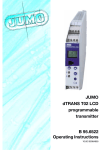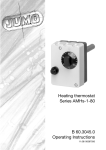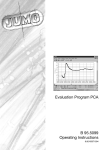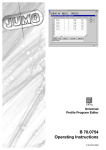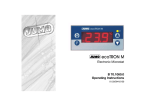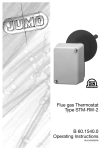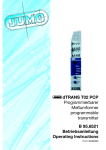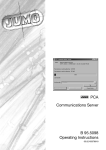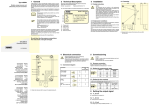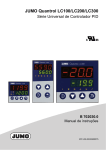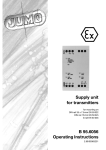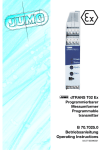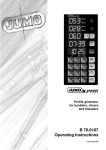Download JUMO dTRANS T02 programmable transmitter B 95.6521 Operating
Transcript
JUMO dTRANS T02 programmable transmitter B 95.6521 Operating Instructions 5.00/00380664 Overview of operation 1 Type designation JUMO dTRANS T02 (1) Basic version 956521 x x x x x x programmable transmitter (2) Input (programmable) 888 factory-set (Pt100 DIN vl) 999 customized configuration1 (3) Output (proportional DC current - programmable) 888 factory-set (0 — 20mA) 999 customized configuration (4 — 20mA or 0 — 10V) (4) Supply 22 20 — 53V AC/DC, 48 — 63Hz 23 110 — 240V +10/-15% AC, 48 — 63Hz (1) Order code Order example (2) / (3) - (4) - 956521 / 888 - 888 - 23 1. For customized configuration, please specify sensor type and range in plain text Standard accessory - 1 Operating Instructions 95.6521 Accessories - PC setup program, multilingual - PC interface cable with TTL/RS232 converter and adapter 1 2 Installation Connection diagram Connection for Supply Analog inputs Resistance thermometer / potentiometer in 4-wire circuit Resistance thermometer / potentiometer in 3-wire circuit Resistance thermometer / potentiometer in 2-wire circuit RL ≤ 15Ω (RL = lead resistance per conductor) 2 2 Installation Thermocouple Resistance transmitters in 3-wire circuit Voltage input up to 1V Voltage input 1V and above Current input Analog outputs Voltage output Current output Digital outputs Open-Collector output 1 Open-Collector output 2 3 2 Installation Installation notes ! The choice of cable, the installation and the electrical connection must conform to the requirements of VDE 0100 “Regulations on the Installation of Power Circuits with nominal voltages below 1000V”, or the appropriate local regulations. ! The electrical connection, as well as work inside the instrument, must only be carried out by properly qualified personnel. ! Ensure that the instrument is completely isolated from the supply before carrying out work where live components may be touched. ! A current limiting resistor (safety function) interrupts the supply circuit in the transmitter in the event of a short-circuit. The external fuse of the supply should not be rated above 1A (slow). ! Avoid magnetic or electric fields, such as caused by transformers, mobile phones or electrostatic discharge, in the neighborhood of the instrument1. ! Do not install inductive loads (relays, solenoid valves etc.) in the vicinity of the instrument; use RC networks, spark quenchers or freewheel diodes for interference suppression. ! Run input, output and supply lines separately, and not parallel to each other. Route cable pairs close together and twisted, if possible. ! Sensor lines must be twisted and shielded. Do not run them close to current-carrying components or cables. Earth the shielding at one end on the instrument. ! Do not connect any additional loads to the supply terminals of the instrument. ! The instrument is not suitable for operation in areas with an explosion hazard. 4 2 Installation ! An electrical connection which deviates from the connection diagram may result in the destruction of the instrument. ! If the mains supply is subject to interference (e. g. thyristor controls), the instrument should be supplied via a isolating transformer. ! Supply fluctuations are only permissible within the specified tolerances1. 1. see Data Sheet Dimensions 5 3 Displays and controls interface for PC setup program LEDs for operational status sockets for measuring the output signal push-buttons for operating the parameter level Operational status at the operating level (normal operation) Illumination/blink behavior Limit comparator 1 inactive 2 inactive Limit comparator 1 active 2 inactive Limit comparator 1 inactive 2 active Limit comparator 1 active 2 active Overrange 6 3 Displays and controls Operational status at the parameter level (programming mode) Illumination/blink behavior Limit for limit comparator 1 Limit for limit comparator 2 Fine calibration (zero point) Fine calibration (full scale) Teach-in (0 % value) Differentiation of the operational states - In the Operating level status, the power LED is on permanently. - In the Parameter level status, the power LED blinks (equally on and off). 7 4 Functions and operation You can operate the transmitter by using the “Span” and “Zero” push-buttons in conjunction with the blink cycles of the “Power” and “Status” LEDs that have already been described in Chapter 3 “Displays and controls”. In use, two operating states can be distinguished: - Operating level (normal operation) - Parameter level (programming mode) Operating level The transmitter is at the operating level two seconds after poweron, or after leaving the parameter level. Parameter level You can access the parameter level by simultaneously pressing the push-buttons “Span” and “Zero” (for at least 5 seconds). The following functions can be programmed at this level: - Limit value for limit comparator 1 - Limit value for limit comparator 2 - Fine calibration (zero point) - Fine calibration (full scale) - Teach-in The parameter level is exited (quit) after editing the “Teach-in” parameter, or if no push-button has been pressed for at least 20 seconds. The individual parameters can be altered, one after another. You can move from parameter to parameter by simultaneously pressing the two push-buttons “Span” and “Zero” for less than 1 second. 8 4 Functions and operation Incrementing values The “Span” push-button is used to increase a value (+) when programming the parameters “Limit 1 and 2” and “Fine calibration” (zero point and full scale). Decrementing values The “Zero” push-button is used to decrease a value (-) when programming the parameters “Limit 1 and 2” and “Fine calibration” (zero point and full scale). Accepting values If a setting has been altered, the push-button combination “Span” + “Zero” has to be pressed simultaneously, to accept the alteration. The “Span” + “Zero” combination has a twofold function: - Acceptance of altered values - Calling the next parameter Value check During programming, the momentary value can be checked at the test sockets (Test + and Test -) with the aid of an ammeter, or at the voltage output using a voltmeter. H H With activated parameter level, the analog output will not be operated according to the input circuit connection when programming the two limit values but with the momentary limit value. Please note that the programming of the “Teach-in” parameter deviates from the standard operation. See “Teach-in” on page 12. 9 4 Functions and operation Setting the limit values (limit comparators) You can alter the limit values by using the “Span” and “Zero” pushbuttons. The momentary value will be produced via the output. The value is accepted by simultaneously pressing “Span” and “Zero”. “Span” and “Zero” can always be used to set the limit values. However, the limit query can only be activated through the PC setup program, which is available as an extra code. There you can also define the limits for the differential. Two functions are available for limit monitoring. With the help of the setup program, you can decide which one to use. Function lk7: Function lk8: 10 4 Functions and operation Fine calibration (zero point and full scale) Fine calibration can be used to adjust the zero point and the slope of the output signal. Here, too, the “Span” and “Zero” push-buttons are available for altering the appropriate value, or for accepting it by simultaneously pressing both push-buttons. The converted value is produced at the output. At zero point, this should correspond to the output signal 0%, at full scale to the output signal 100%. The formula for calculating the new converted value is: output (converted) value = measurement (input) valuescaled x full scale + zero point 11 4 Functions and operation Teach-in The “Teach-in” parameter serves to define the 0 % value. During programming, the zero point (e.g. 4mA) is produced at the output. This value is accepted by pressing the “Zero” push-button (“Zero” only, not together with “Span”). After a time-out without acceptance, the old value will be available again. Example: The position of a valve is detected by a potentiometer. The potentiometer covers the range 50 to 150Ω, with 50Ω corresponding to the valve closed. The range is programmed as follows: - Potentiometer 50 — 150 Ω - Output 0 — 20mA However, because of mechanical tolerances, the potentiometer position is 52Ω with the valve closed, which results in an output current of 0.4mA. Thanks to the “Teach-in” function, this error can be eliminated as described below: - Close valve - Call parameter level and select “Teach-in” (0.4mA should then be present at the output). - Press the “Zero” push-button – the output must now change to 0mA. - Confirm alteration by simultaneously pressing the “Span” and “Zero” push-buttons. - Exit the parameter level (either after a time-out of 20sec, or by pressing “Span and Zero“ again). 12 5 Tips ... ... on operation within the parameter level H A value can only be confirmed by pressing the “Span” and “Zero” push-buttons simultaneously when at least one of the two push-buttons has previously been pressed by itself. If this is not the case, the confirmation will be interpreted as a call of the next parameter. H If both buttons are to be pressed simultaneously but one of them is pressed too early by mistake, an automatic value alteration will occur. When „Span“ and „Zero“ are subsequently properly pressed simultaneously, this will initially prompt the acceptance of the altered value. Only when both push-buttons are pressed again, will the next parameter (or normal operation) be called up. H H If, after an unintended alteration, the value is not to be accepted, just wait for the time-out of 20 sec. Afterwards, the instrument will automatically jump back to normal operation without accepting the alteration. Please note that the programming of the “Teach-in” parameter differs from the standard operation. See “Teach-in” on page 12. H It is always possible to set the limit values via the “Span” and “Zero” push-buttons. However, the limit query can only be activated with the aid of the setup program, which is available as an extra code. You can also define the differential limits there. 13 5 Tips ... ... of a more general nature H If none of the parameters can be altered, then you may have locked the operation on the instrument through the setup program. Please check the setting with the help of the setup program. The instrument settings can only be changed when “Operating level” and “Parameter level” are set to “none”. H A Both outputs (current and voltage) are always available at the same time. However, the output that has not been activated in the setup program, or by the default setting, only has an accuracy of approximately ± 2% of full scale. The frequency output will not be operated as long as the setup plug remains plugged in. 14 6 PC setup program Operation on the transmitter permits the alteration of only a few parameters. Using the PC setup program, which is available as an extra code, all parameters of the transmitter can be conveniently altered. Through the setup interface, the transmitter and the PC are connected to each other via the “PC interface with TTL/RS232 converter and adapter”. Configurable parameters - TAG number (10 characters) - analog input (sensor type) - connection circuit (2-/3-/4 wire) - external or constant cold junction - customized linearization - range limits (start and end) - output signal current/voltage/frequency rising/falling - digital filter - response to probe break/short-circuit - recalibration/fine calibration - instrument calibration - limit value/differential of limit comparators - file-info text Additional benefits of the PC setup program - manage several different settings - one setting for a number of transmitters - print out setting for documentation - operation can be switched to GMA standard A The frequency output will not be operated as long as the setup plug remains plugged in. 15 M. K. JUCHHEIM GmbH & Co JUMO Instrument Co. Ltd. Street address: Moltkestraße 13 - 31 36039 Fulda, Germany Delivery address: Mackenrodtstraße 14 36039 Fulda, Germany Postal address: 36035 Fulda, Germany Phone: +49 (0) 661 60 03-0 Fax: +49 (0) 661 60 03-5 00 E-Mail: [email protected] Internet: www.jumo.de JUMO House Temple Bank, Riverway Harlow, Essex CM20 2TT, UK JUMO PROCESS CONTROL INC. 735 Fox Chase, Coatesville, PA 19320, USA Phone: 610-380-8002 1-800-554-JUMO Fax: 610-380-8009 Phone: +44 (0) 1279 63 55 33 E-Mail: [email protected] Fax: +44 (0) 1279 63 52 62 E-Mail: [email protected] Internet: www.JumoUSA.com




















